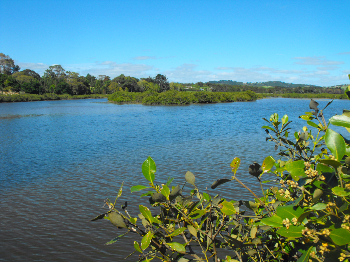
MANGAWHAI'S NO.1 NEWSPAPER
|
|
|
Mangroves matter say some experts The attributes of Mangawhai’s mangroves were given a positive boost recently, as qualified speakers voiced their knowledge and expertise regarding the importance of the controversial water plant. The attributes of Mangawhai’s mangroves were given a positive boost recently, as qualified speakers voiced their knowledge and expertise regarding the importance of the controversial water plant.Hosted by the New Zealand Fairy Tern Trust and Forest & Bird Society, the free community talk Mangroves Matter - Mangawhai, Mangroves and Rare Birds attracted a crowd of 80-plus to Mangawhai’s Senior Citizens’ Hall on March 19, eager to hear from the seven leading experts. Presenters spoke of the unique ecology of Mangawhai Harbour, emphasising the vital importance of the mangrove bio-network especially in reference to the feeding and breeding habitat for bird life. Mangawhai’s mangroves are home to the largest remaining breeding population of New Zealand’s rare fairy tern and both Dr Steffi Ismar, an honourary research associate at the University of Auckland, and Dr Tony Beauchamp from the Department of Conservation, spoke specifically about the vulnerability of the birds. “Fairy terns are very site-fixed. Big changes in the environment are probably detrimental,” Dr Beauchamp says. “It is difficult to estimate what a rapid change – like removing mangroves – would do.” NZ Fairy Tern Trust Convenor, Heather Rogan, commented on the difference in breeding numbers from last year. “It may be pure coincidence, but the last breeding season, following mangrove removal, was the worst for many years at Mangawhai, with only two chicks fledging from only five eggs laid,” she says. “In stark contrast, last season 18 eggs were laid at Mangawhai.” Committee members from the Mangawhai Harbour Restoration Society (MHRS) were also present at the meeting. “When asked why they had removed mangroves in the past and wanted to do more mangrove removal in the future, a spokesperson was unable to give any reasons apart from saying that they were charged with maintaining flows through the channels,” Rogan says. Scientist Dr Mark Bellingham and Ian Southey from Birds New Zealand talked of the ‘fascinating ecology of mangroves’ and the secret life of birds who reside in the plants. Dr Roger Grace pointed out that mangroves have been here long before humans arrived and, when coastal forest has been cleared to the waters’ edge, mangrove forests can provide a ‘wildlife corridor’. “By removing mangroves, people are hoping for clear sandy beaches, but a more predictable result is erosion and dumping of rubble in attempts to stabilise the margins.” Seabird Advocate for Forest & Bird and co-chairperson of the event, Karen Baird says the regional coastal plans in Northland are currently under review and strengthening the protection of important ecological habitats such as Mangawhai Harbour will be a priority in this process. “We have already started this conversation with the council but are up against organisations such as MHRS who want the rules around mangrove removal relaxed so they can apply to remove an area below the Molesworth Drive Bridge,” she says. “This area has already been excluded previously from removal by the environment court and is the largest remaining area of mangroves which support high densities of the fairy tern’s favourite food, the goby fish.” Baird says the organiser’s intentions were to increase people’s appreciation and understanding of the rich significance of the mangrove eco-system in Mangawhai and it seems the message has had impact. “We’d always been led to believe that mangroves weren’t native and that was a reason for pulling them out,” one local attendee said, “But being here for 19 million years sure makes them native!”
ARM WRESTLE: Local organisations continue to argue the pros and cons of mangrove removal. PHOTO/Julia Wade “It may be pure coincidence, but the last breeding season, following mangrove removal, was the worst for many years at Mangawhai, with only two chicks fledging from only five eggs laid.” - Heather Rogan, NZ Fairy Tern Trust Convenor By Julia Wade |


